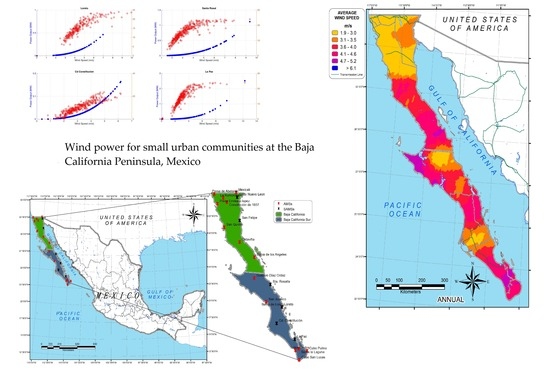Wind Energy Assessment for Small Urban Communities in the Baja California Peninsula, Mexico
Abstract
:1. Introduction
2. Materials and Methods
2.1. Data
Linear Regression Data at the Baja California Peninsula
2.2. Wind Assessment at Baja California Peninsula
2.2.1. Wind Speed
2.2.2. Wind Power Density
2.2.3. Weibull Distribution
2.2.4. Power and Energy Output
2.2.5. Useful Hours
2.3. Wind Speed and WPD Maps GIS-Based
3. Results
3.1. Data Validation
3.2. Weibull Distribution
3.3. Wind Speed Assessment at the Baja California Peninsula
3.4. Wind Speed and WPD Maps
3.5. Wind Speed, Power Output Generated and Useful Hours
4. Discussion
5. Conclusions
Acknowledgments
Conflicts of Interest
Abbreviations
| AHP | Analytical Hierarchy Process |
| VIKOR | Compromise Ranking Method |
| HOMER | Hybrid Optimization of Multiple Energy Resources |
| RES | Renewable Energy Sources |
| VAC | Voltage in Alternating Current |
| CFE | Federal Commission of Electricity |
| GIS | Geographic Information System |
| PV | Photovoltaic |
| AMSs | Automatic Meteorological Stations |
| SAMSs | Synoptic Automatic Meteorological Stations |
| NMS | National Meteorology Service of Mexico |
| SMSE | Surface Meteorology and Solar Energy |
| NASA | National Aeronautics and Space Administration |
| RMSE | Root Mean Square Error |
| SD | Standard Deviation |
| WPD | Wind Power Density |
| ASDC | Atmospheric Science Data Center |
| BLUE | Best Linear Unblased Estimators |
| OK | Ordinary Kriging |
| UK | Universal Kriging |
References
- Secretaría de Energía (SENER). Available online: http://www.sener.gob.mx (accessed on 2 January 2016).
- The World Bank. Available online: http://www.data.worldbank.org/indicator/SI.POV.RUHC (accessed on 3 January 2016).
- International Energy Association (IEA). Available online: http://www.iea.org/statistics/statisticssearch/report/?country=Mexico&product=electricityandheat (accessed on 10 January 2016).
- Secretaría de Energía (SENER). Balance de Energía 2014. Available online: http://www.gob.mx/cms/uploads/attachment/file/44353/Balance_Nacional_de_Energ_a_2014.pdf (accessed on 10 January 2016).
- Analysis of Mexico’s New Electricity Industry Law. 2014. Available online: https://m.mayerbrown.com/Files/Publication/15cb6f04-748b-4836-a607-26c65997c1c1/Presentation/PublicationAttachment/0f38ad29-4abf-442b-aef9-319d68469310/UPDATE-AnalysisElectricityLaw_0814.pdf (accessed on 1 March 2016).
- Ley de Transicion Energetica, Mexico. Available online: http://www.dof.gob.mx (accessed on 24 May 2016).
- International Energy Association. IEA Wind Task 26. The Past and Future Cost of Wind Energy. Available online: https://www.ieawind.org/index_page_postings/WP2_task26.pdf (accessed on 14 January 2016).
- Gutierrez-Vera, J. Use of renewable sources of energy in Mexico case: San Antonio Agua Bendita. IEEE Trans. Energy Convers. 1994. [Google Scholar] [CrossRef]
- Huacuz, J.; Agredano, J. Beyond the grid: Photovoltaic electrification in rural Mexico. Progress Photovolt. 1998, 6, 379–395. [Google Scholar] [CrossRef]
- Federal Commission of Electricity. Available online: http://www.cfe.gob.mx/ConoceCFE/1_AcercadeCFE/Lists/Publicaciones/Attachments/61/ProgramaSENERV2.pdf (accessed on 16 January 2016).
- Masera, O. Sustainable Fuelwood Use in Rural Mexico. Available online: http://www.apps.webofknowledge.com/UA_GeneralSearch_input.do?product=UA&search_mode=GeneralSearch&SID=4BtQy8KMrELICBqS1uL&preferencesSaved (accessed on 16 January 2016).
- Comisión Nacional Para el Uso Eficiente de la Energía. Available online: http://www.conuee.gob.mx/ (accessed on 20 January 2016).
- Hernández-Escobedo, Q.; Manzano-Agugliaro, F.; Zapata-Sierra, A. The wind power of Mexico. Renew. Sustain. Energy Rev. 2010, 14, 2830–2840. [Google Scholar] [CrossRef]
- Sliz-Szkliniarz, B.; Vogt, J. GIS-based approach for the evaluation of wind energy potential: A case study for the Kujawsko-Pomorskie Voivodeship. Renew. Sustain. Energy Rev. 2011, 15, 1696–1707. [Google Scholar] [CrossRef]
- Aydin, N.Y.; Kentel, E.; Duzgun, S. GIS-based environmental assessment of wind energy systems for spatial planning: A case study from Western Turkey. Renew. Sustain. Energy Rev. 2010, 14, 364–373. [Google Scholar] [CrossRef]
- Hernández-Escobedo, Q.; Saldaña-Flores, R.; Rodríguez-García, E.R.; Manzano-Agugliaro, F. Wind energy resource in Northern Mexico. Renew. Sustain. Energy Rev. 2014, 32, 890–914. [Google Scholar] [CrossRef]
- Ramachandra, T.V.; Shruthi, B.V. Wind energy potential mapping in Karnataka, India, using GIS. Energy Convers. Manag. 2005, 46, 1561–1578. [Google Scholar] [CrossRef]
- Su, M.C.; Kao, N.H.; Huang, W.J. Potential assessment of establishing a renewable energy plant in a rural agricultural area. J. Air Waste Manag. Assoc. 2012, 62, 662–670. [Google Scholar] [CrossRef] [PubMed]
- Agugliaro, F.M. Gasification of greenhouse residues for obtaning electrical energy in the south of Spain: Localization by GIS. Interciencia 2007, 32, 131–136. [Google Scholar]
- Viana, H.; Cohen, W.B.; Lopes, D.; Aranha, J. Assessment of forest biomass for use as energy. GIS-based analysis of geographical availability and locations of wood fired power plants in Portugal. Appl. Energy 2010, 87, 2551–2560. [Google Scholar] [CrossRef]
- Gil, M.V.; Blanco, D.; Carballo, M.T.; Calvo, L.F. Carbon stock estimates for forests in the Castilla y León region, Spain. A GIS based method for evaluating spatial distribution of residual biomass for bio-energy. Biomass Bioenergy 2011, 35, 243–252. [Google Scholar] [CrossRef]
- Hiloidhari, M.; Baruah, D.C. Rice straw residue biomass potential for decentralized electricity generation: A GIS based study in Lakhimpur district of Assam, India. Energy Sustain. Dev. 2011, 15, 214–222. [Google Scholar] [CrossRef]
- Zhang, F.; Johnson, D.M.; Sutherland, J.W. A GIS-based method for identifying the optimal location for a facility to convert forest biomass to biofuel. Biomass Bioenergy 2011, 35, 3951–3961. [Google Scholar] [CrossRef]
- Ghilardi, A.; Guerrero, G.; Masera, O. A GIS-based methodology for highlighting fuel wood supply/demand imbalances at the local level: A case study for Central Mexico. Biomass Bioenergy 2009, 33, 957–972. [Google Scholar] [CrossRef]
- Moreno, A.; Gilabert, M.A.; Martinez, B. Mapping daily global solar irradiation over Spain: A comparative study of selected approaches. Solar Energy 2011, 85, 2072–2084. [Google Scholar] [CrossRef]
- Arnette, A.N.; Zobel, C.W. Spatial analysis of renewable energy potential in the greater southern Appalachian mountains. Renew. Energy 2011, 36, 2785–2798. [Google Scholar] [CrossRef]
- Gastli, A.; Charabi, Y. Solar electricity prospects in Oman using GIS-based solar radiation maps. Renew. Sustain. Energy Rev. 2010, 14, 790–797. [Google Scholar] [CrossRef]
- Liu, M.; Bárdossy, A.; Li, J.; Jiang, Y. GIS-based modelling of topography-induced solar radiation variability in complex terrain for data sparse region. Int. J. Geogr. Inf. Sci. 2012, 26, 1281–1308. [Google Scholar] [CrossRef]
- Vance, E. Mexico sets climate targets. Nature 2012. [Google Scholar] [CrossRef] [PubMed]
- Bravo, J.; Casals, X.; Pascua, I. GIS approach to the definition of capacity and generation ceilings of renewable energy technologies. Energy Policy 2007, 35, 4879–4892. [Google Scholar] [CrossRef]
- Ramachandra, T.V.; Shruthi, B.V. Spatial mapping of renewable energy potential. Renew. Sustain. Energy Rev. 2007, 11, 1460–1480. [Google Scholar] [CrossRef]
- Belmonte, S.; Nuñez, V.; Viramonte, J.G.; Franco, J. Potential renewable energy resources of the Lerma Valley, Salta, Argentina for its strategic territorial planning. Renew. Sustain. Energy Rev. 2009, 13, 1475–1484. [Google Scholar] [CrossRef]
- Ho-Jin, Y.; Jae-Jin, K. Assessment of observation environment for surface wind in urban areas using a CDF model. Korean Meteorol. Soc. 2015, 25, 449–459. [Google Scholar]
- Instituto Nacional de Estadística y Geografía. Available online: http://www.inegi.org.mx (accessed on 30 January 2016).
- Polo, J.; Zarzalejo, L.F.; Cony, M.; Navarro, A.A.; Marchante, R.; Martin, L.; Romero, M. Solar radiation estimations over India using Meteosat satellite images. Sol. Energy 2011, 85, 2395–2406. [Google Scholar] [CrossRef]
- Zelenka, A.; Perez, R.; Seals, R.; Renne, D. Effective accuracy of satellite-derived hourly irradiations. Theor. Appl. Climatol. 1999, 62, 199–207. [Google Scholar] [CrossRef]
- Vignola, F.; Harlan, P.; Perez, R.; Kmiecik, M. Analysis of satellite derived beam and global solar radiation data. Sol. Energy 2007, 81, 768–772. [Google Scholar] [CrossRef]
- Pedro, H.T.C.; Coimbra, C.F.M. Assessment of forecasting techniques for solar power production with no exogenous inputs. Sol. Energy 2012, 86, 2017–2028. [Google Scholar] [CrossRef]
- National Meteorological Service (NMS). Available online: http://www.smn.cna.gob.mx/emas/ (accessed on 1 February 2016).
- Surface and Meteorology Energy System (SMES). Available online: https://www.eosweb.larc.nasa.gov/sse/ (accessed on 1 February 2016).
- Lange, M. On the uncertainty of wind power predictions—Analysis of the forecast accuracy and statistical distribution of errors. J. Sol. Energy Eng. 2005, 127, 177–184. [Google Scholar] [CrossRef]
- Jaramillo, O.A.; Saldana, R.; Miranda, U. Wind power potential of Baja California Sur, Mexico. Renew. Energy 2004, 29, 2087–2100. [Google Scholar] [CrossRef]
- Manwell, J.F.; McGowan, J.G.; Rogers, A.L. Wind Energy Explained, Theory, Design and Application, 1st ed.; Wiley: Chichester, UK, 2009. [Google Scholar]
- Lun, I.; Lam, J. A study of weibull parameters using long term wind observations. Renew. Energy 2000, 20, 145–153. [Google Scholar] [CrossRef]
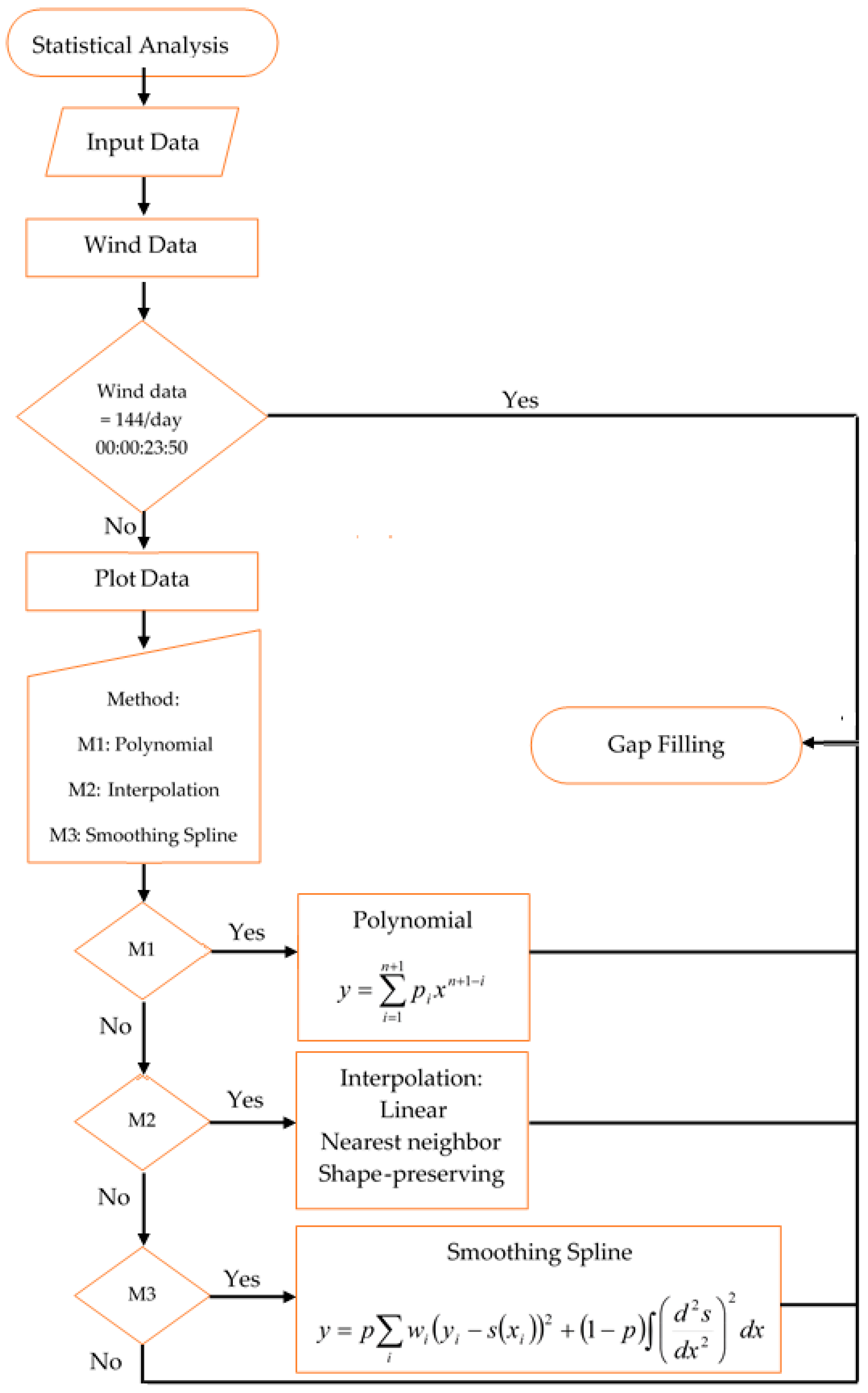
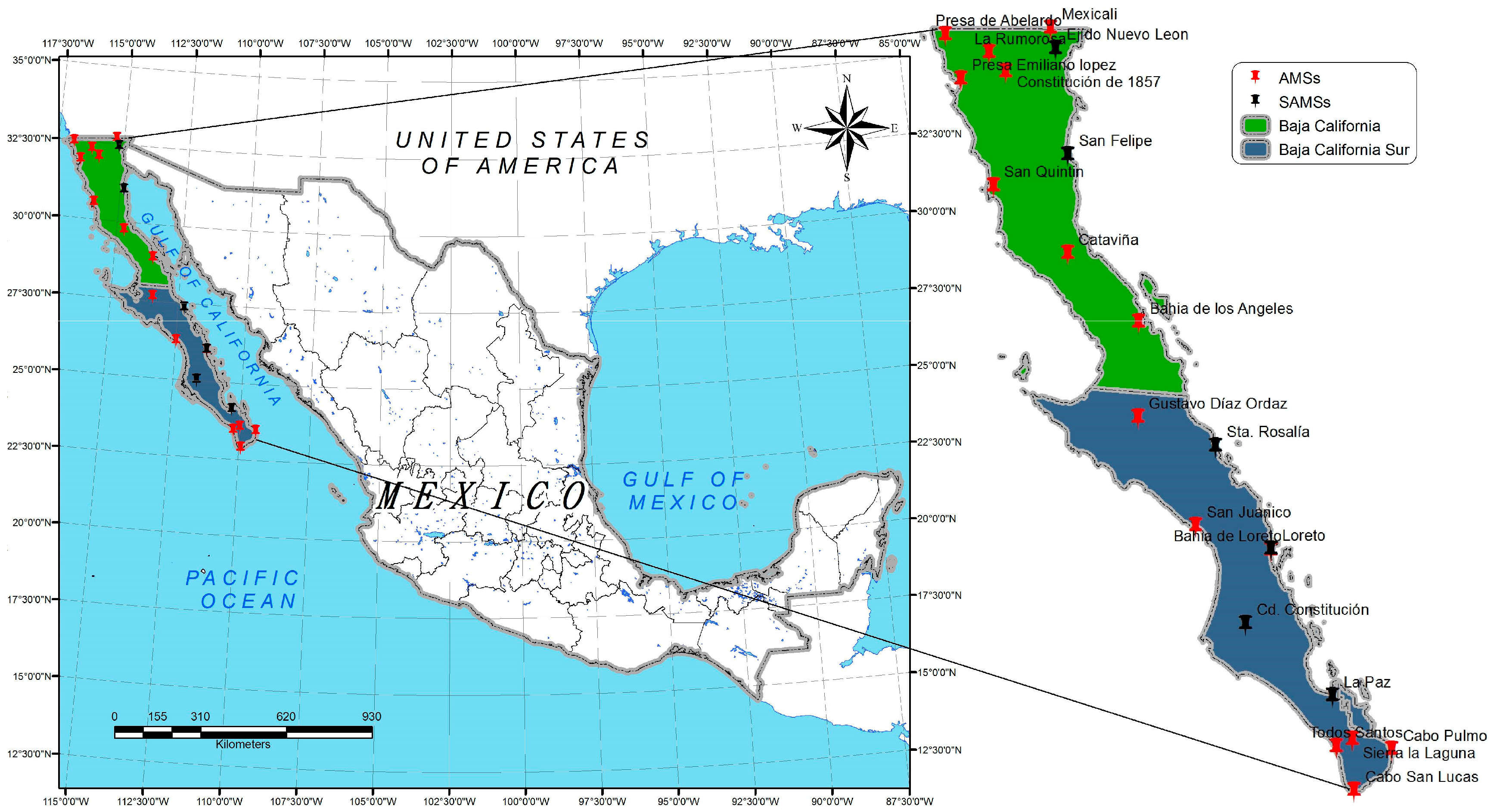
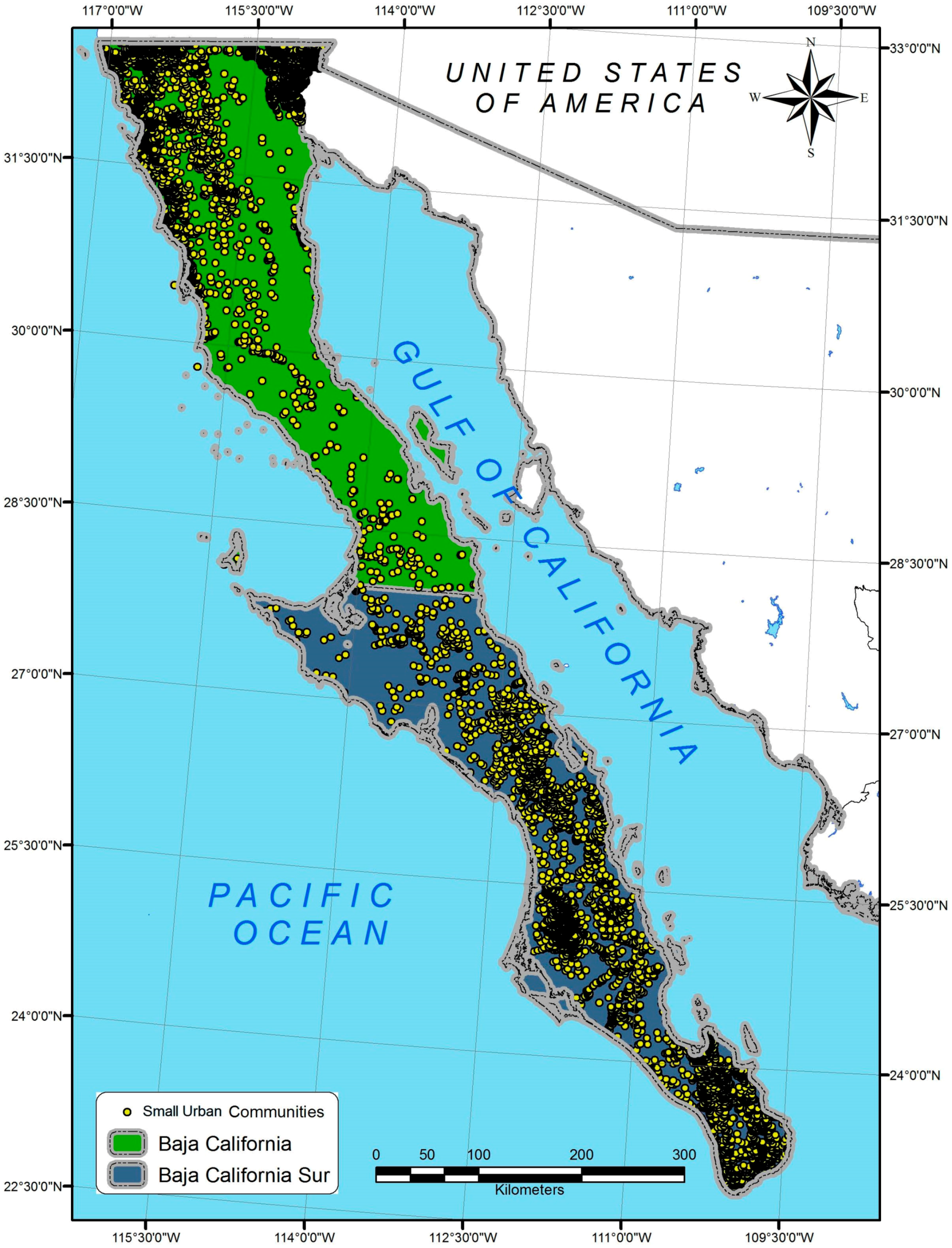
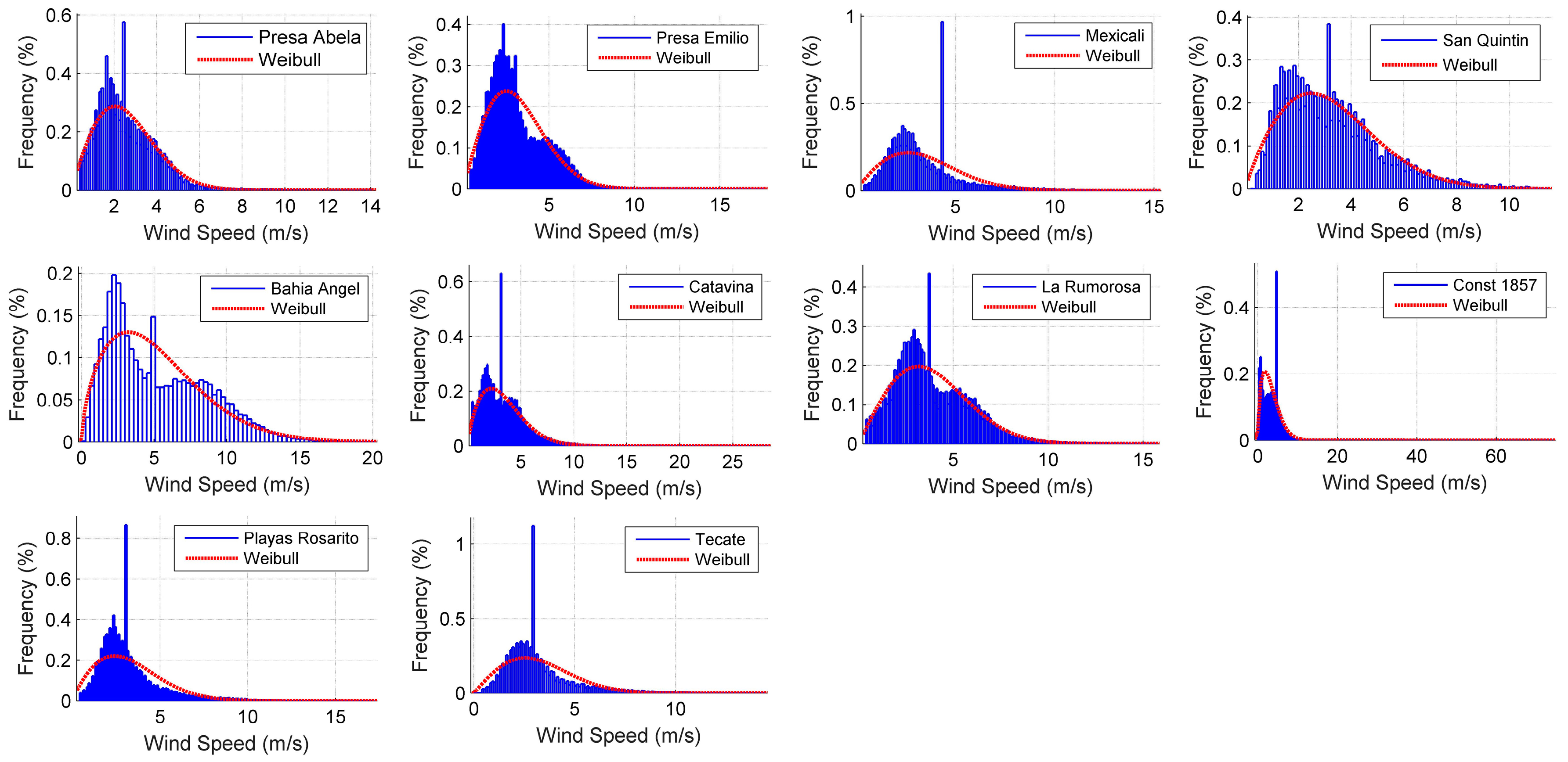
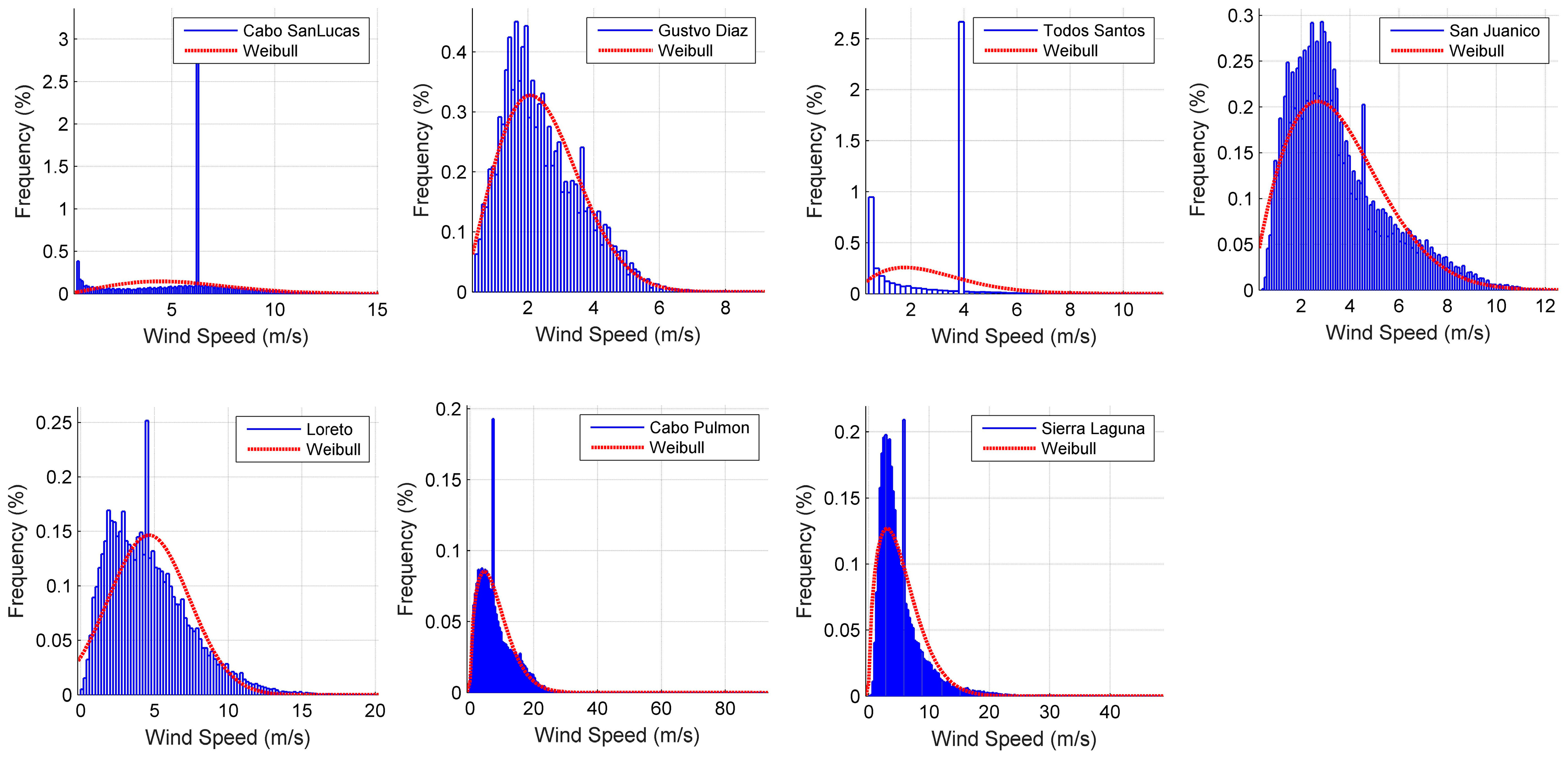
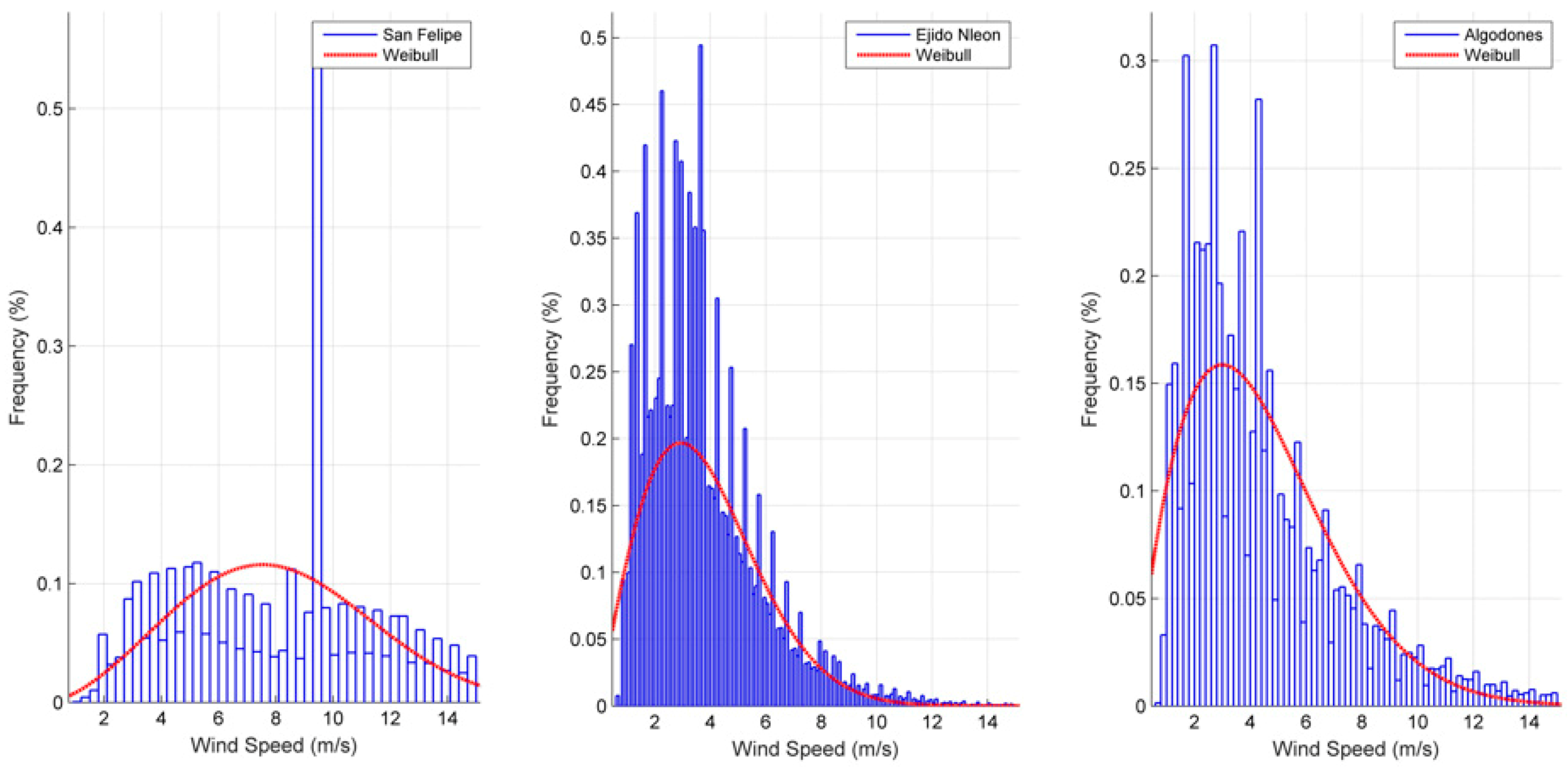

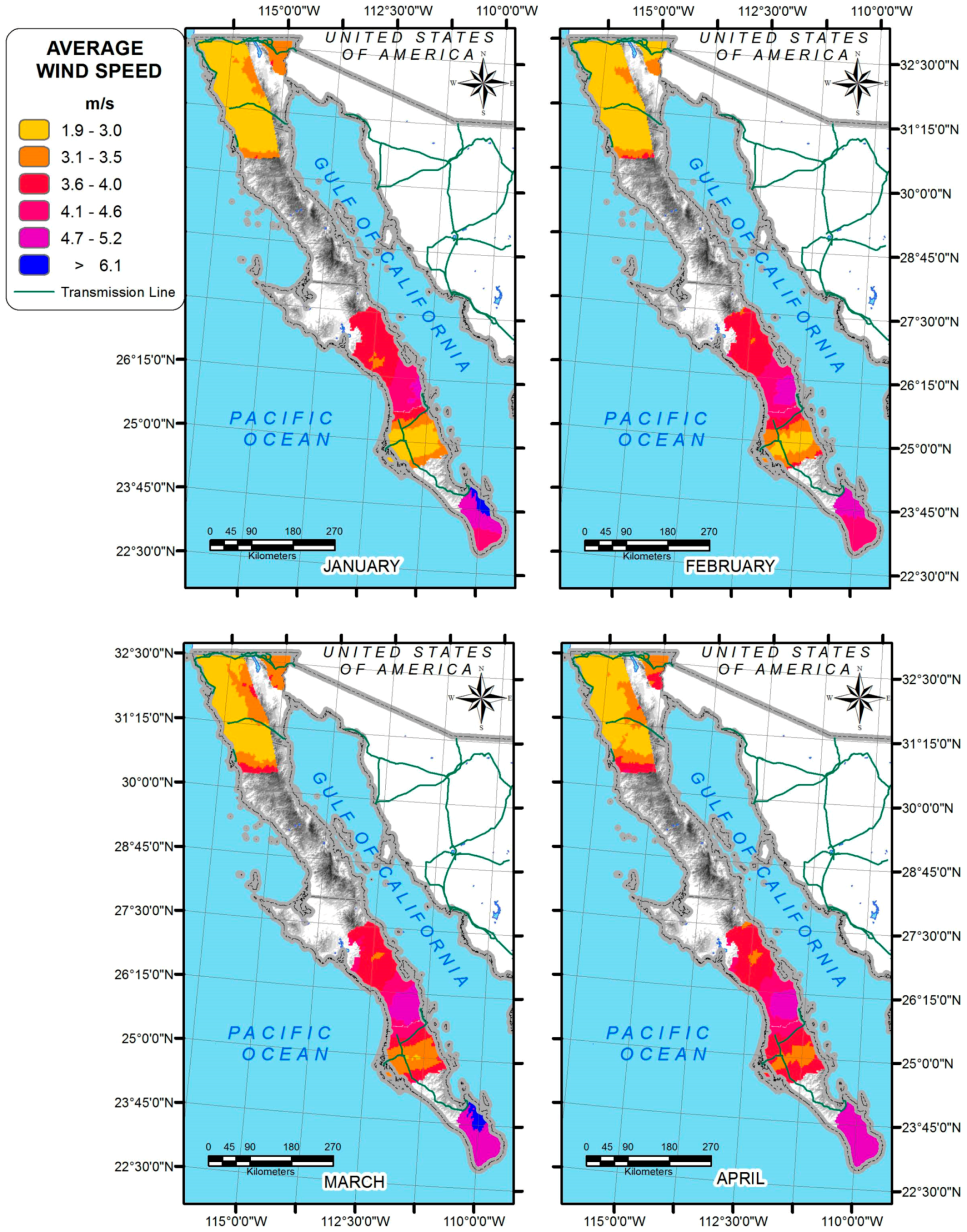
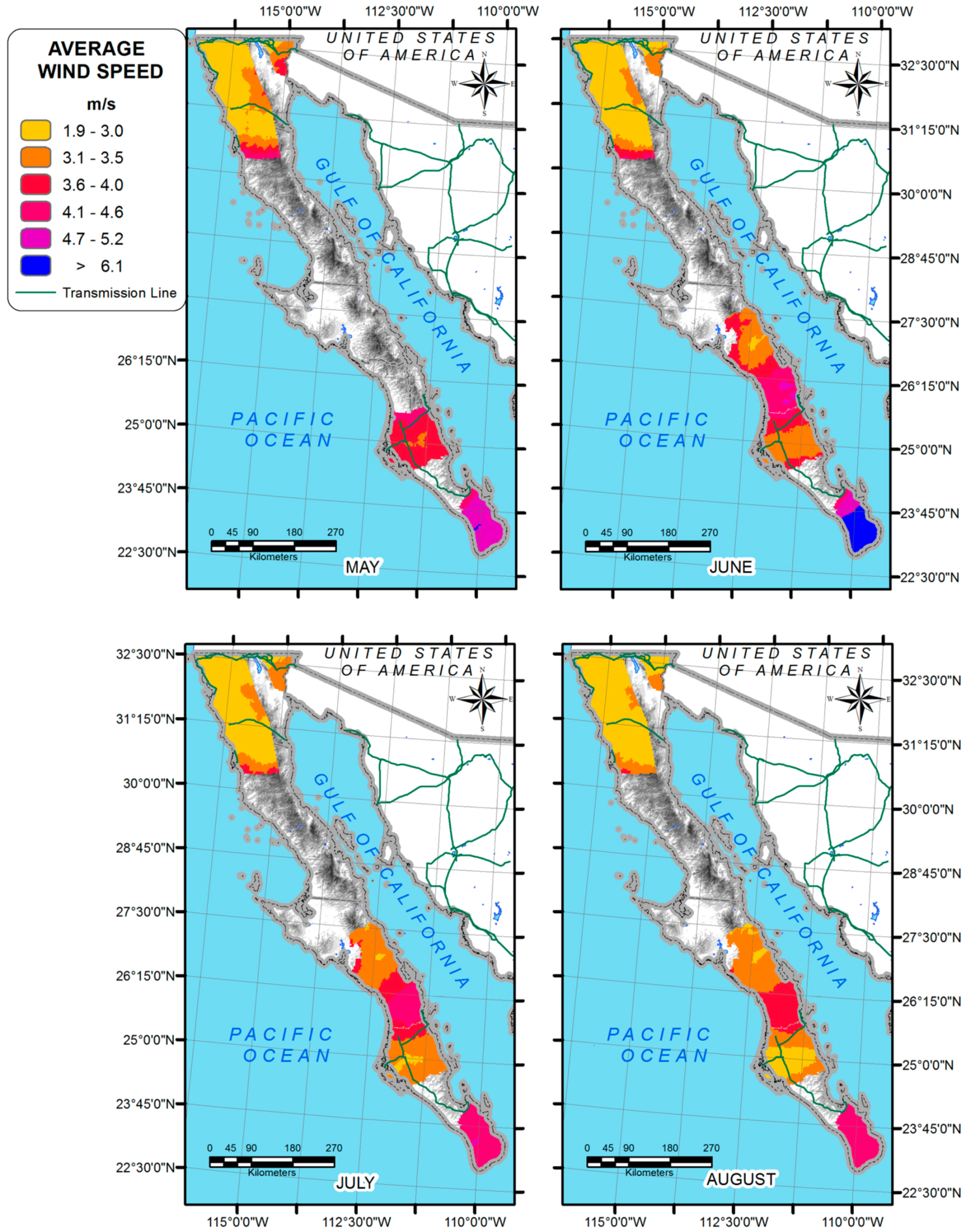
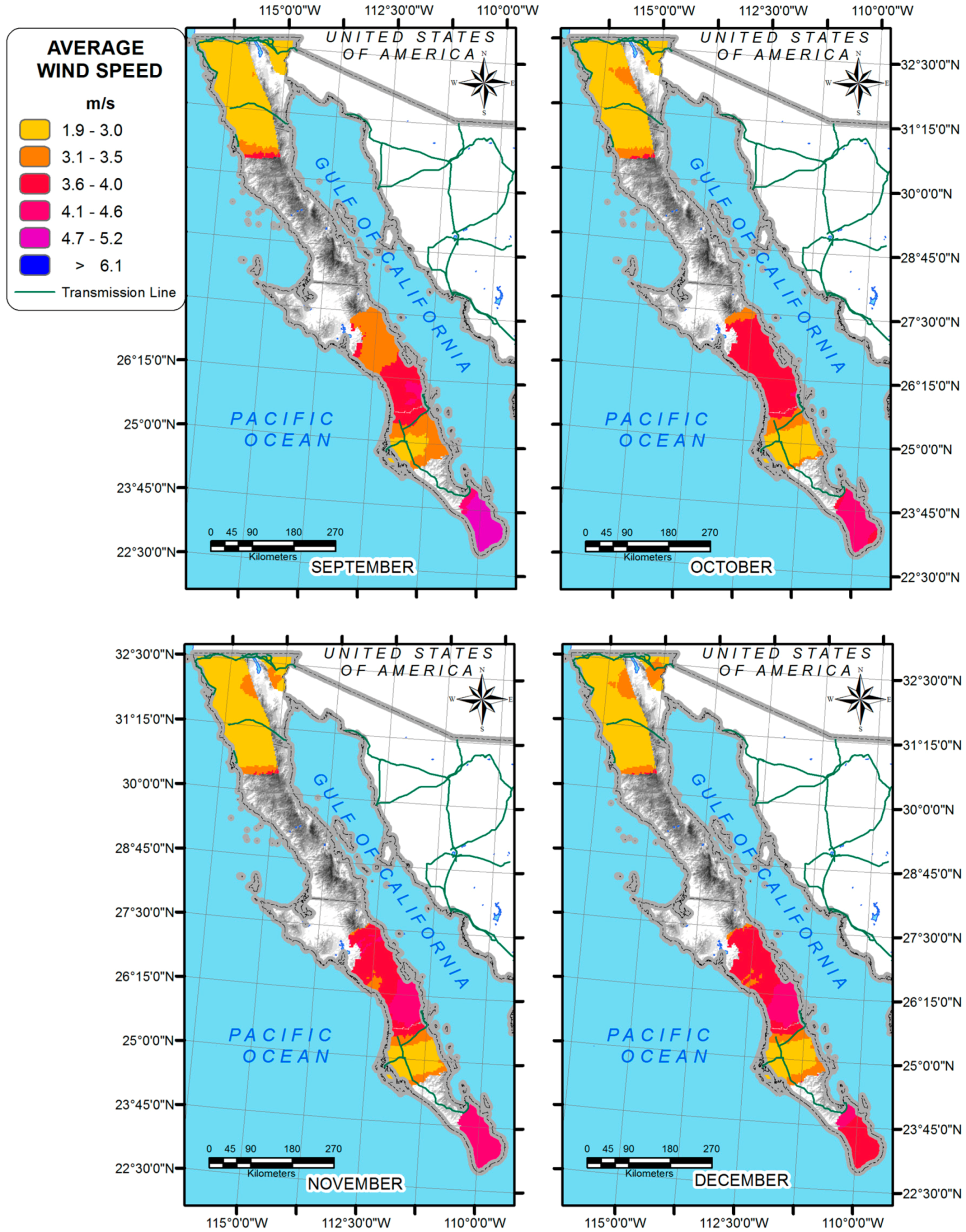
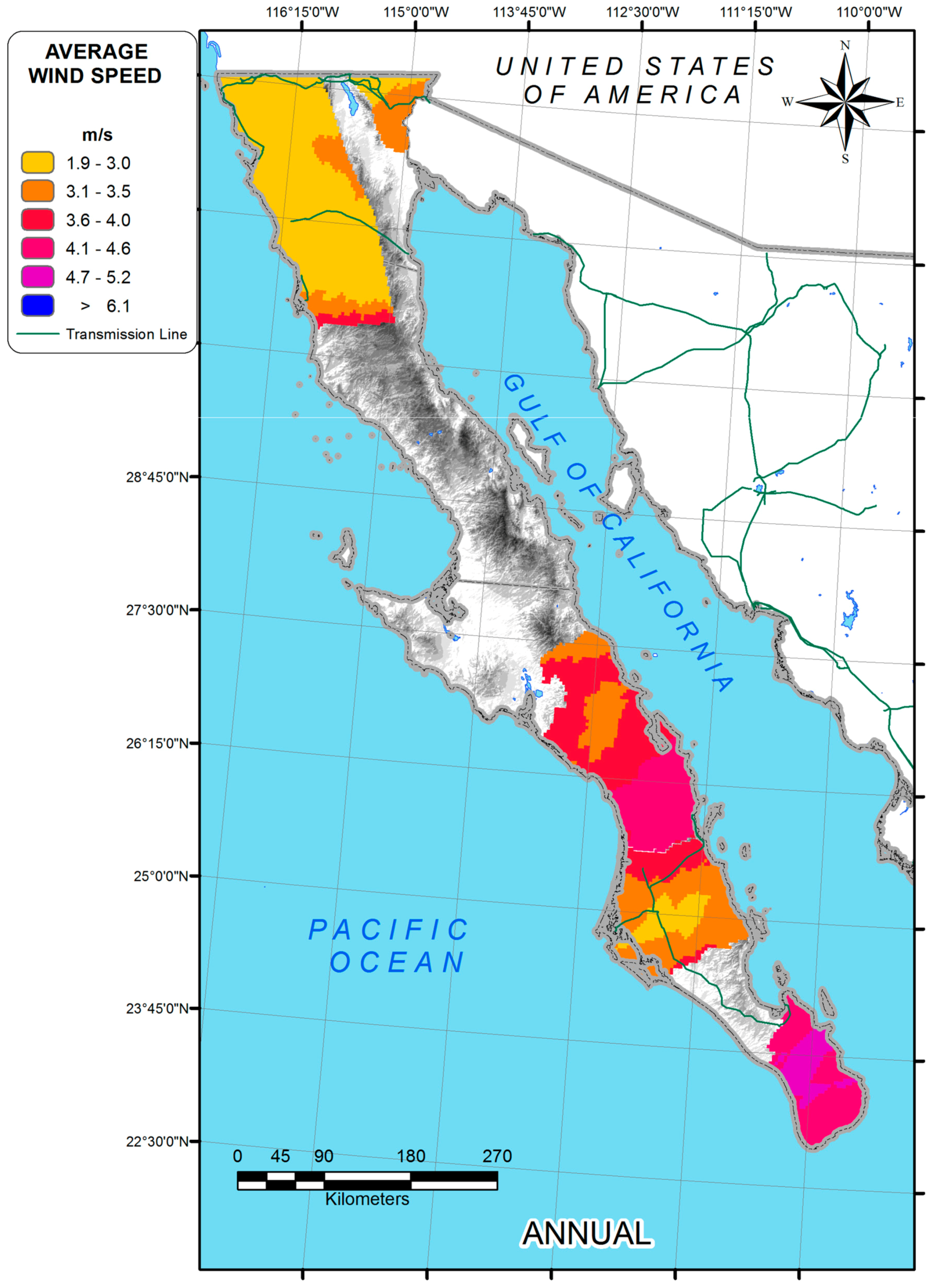
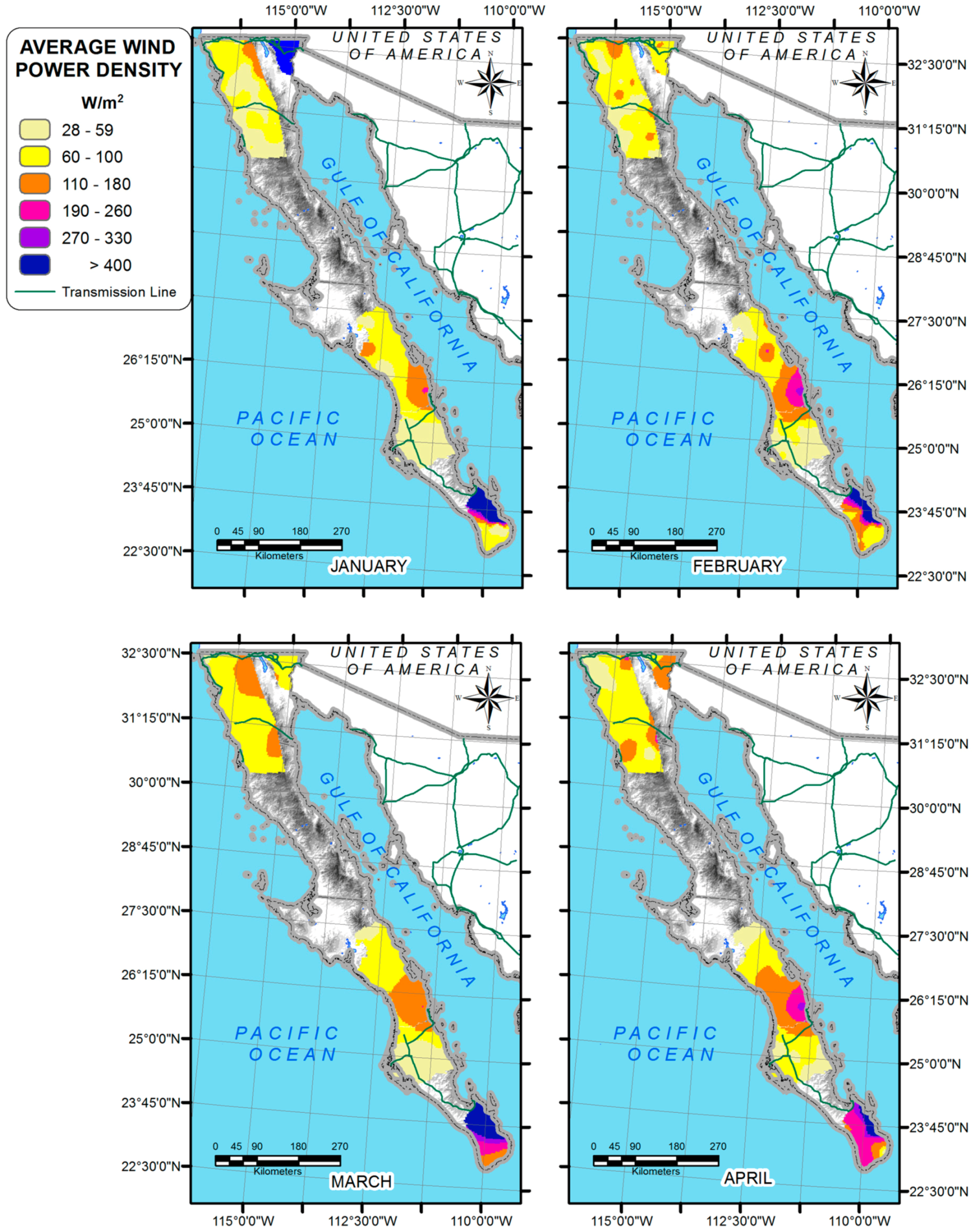
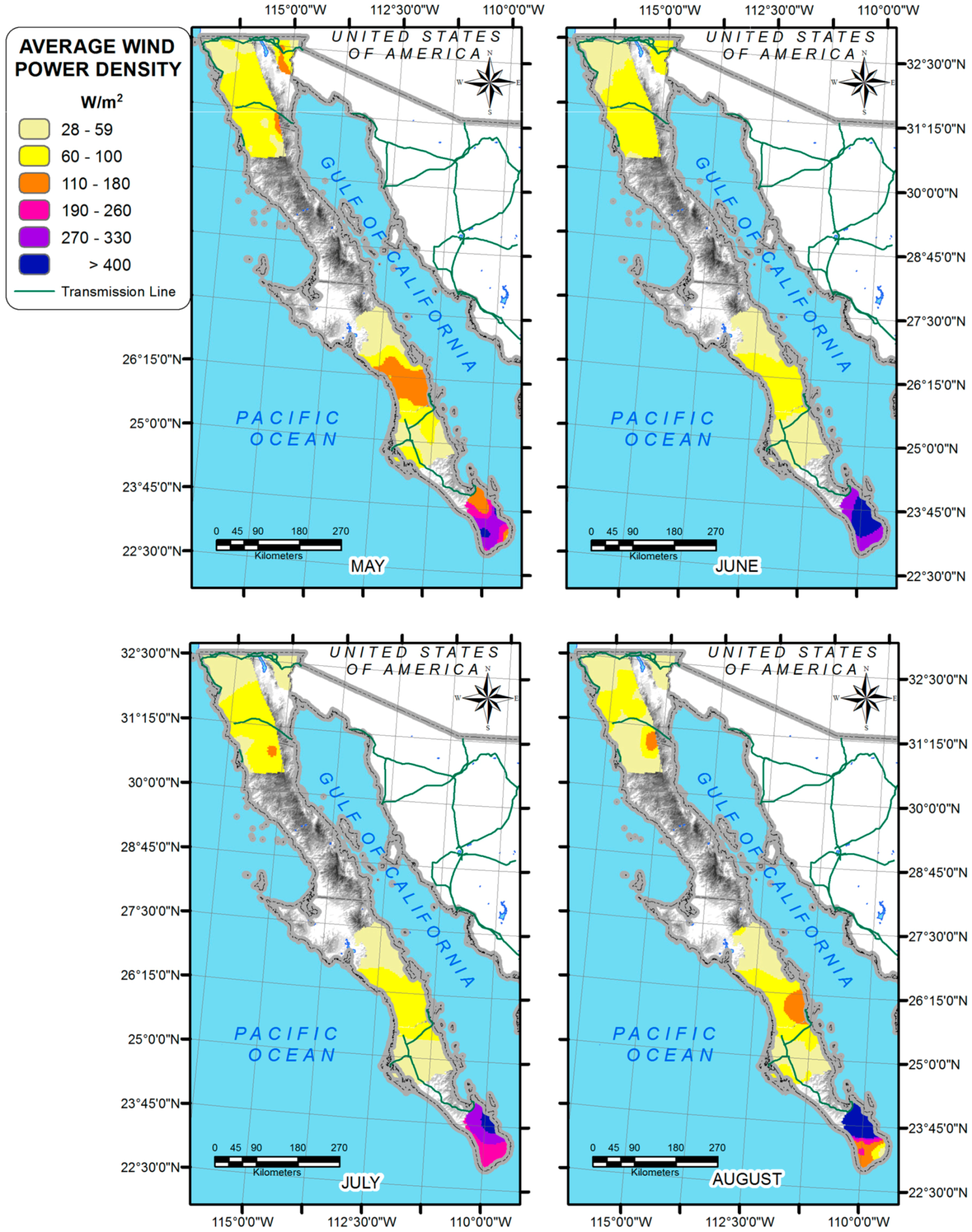
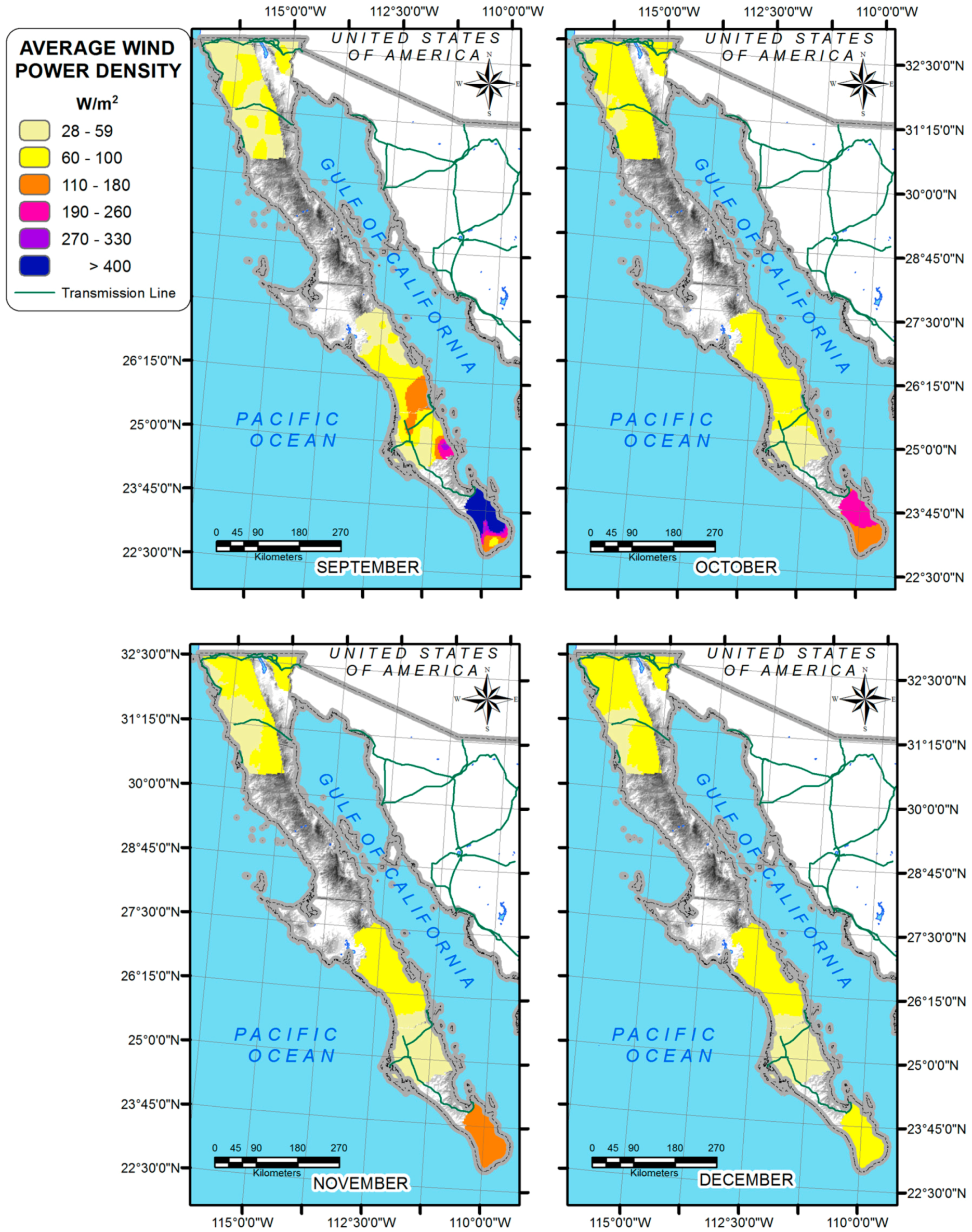
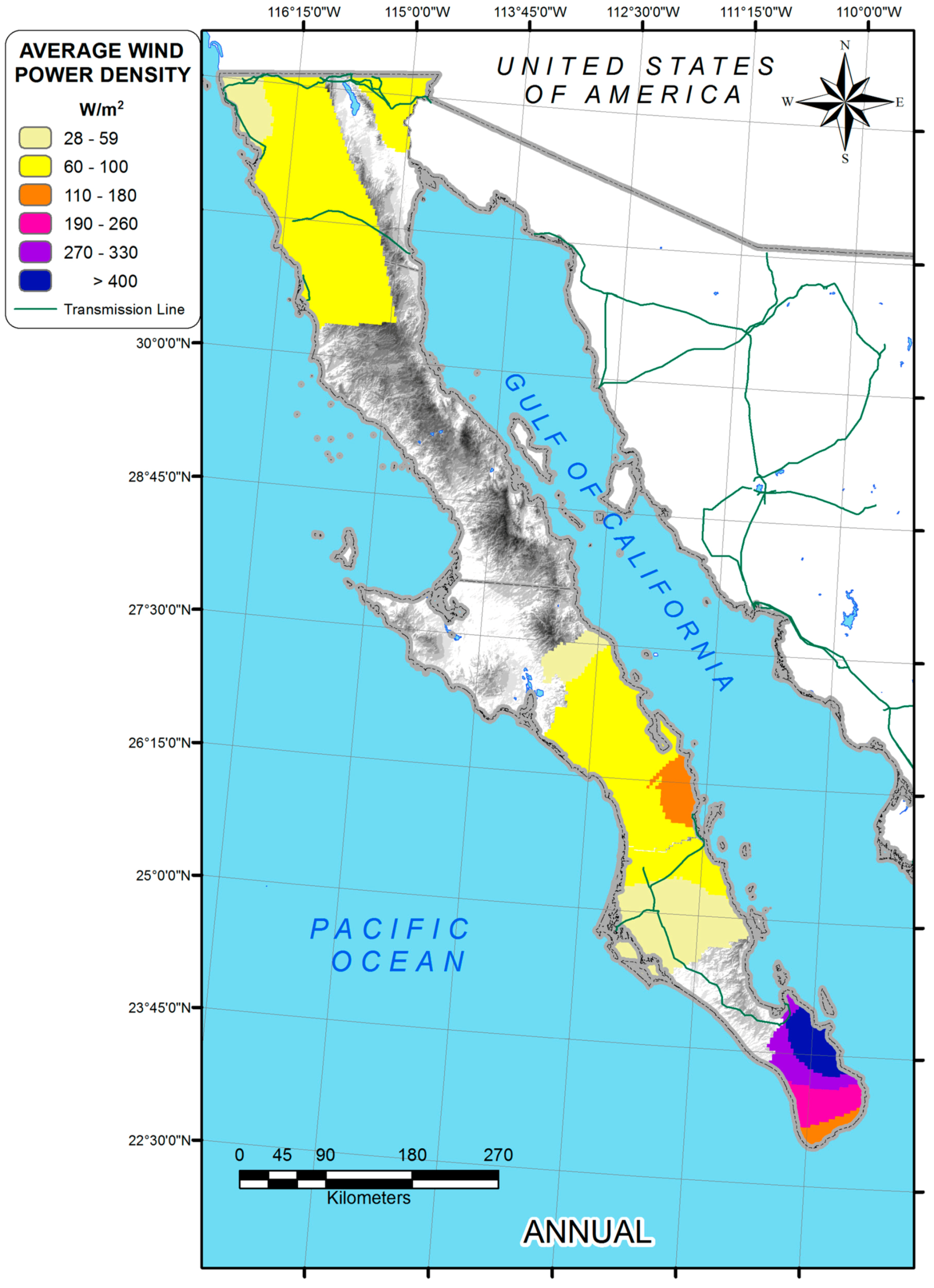
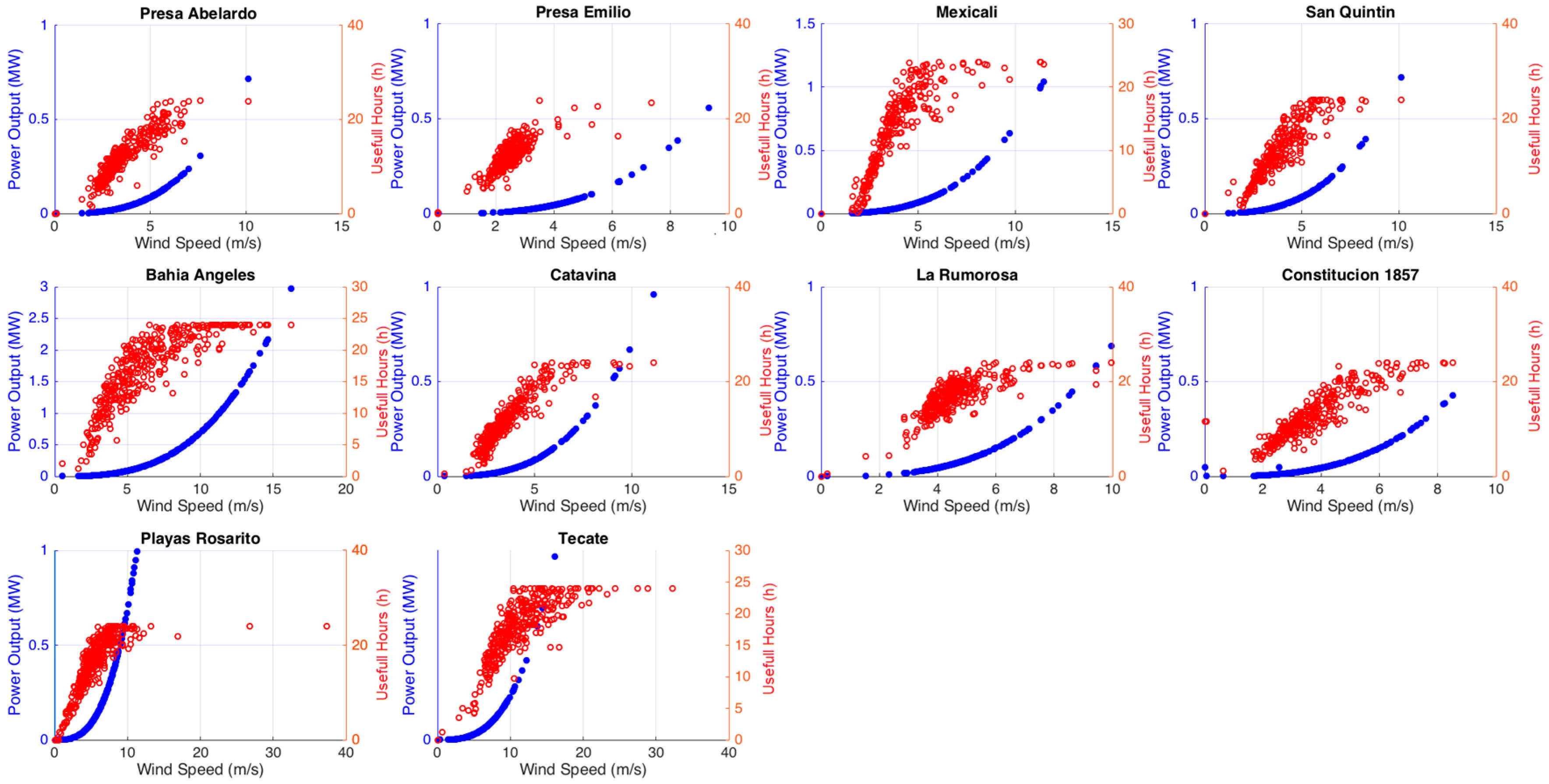
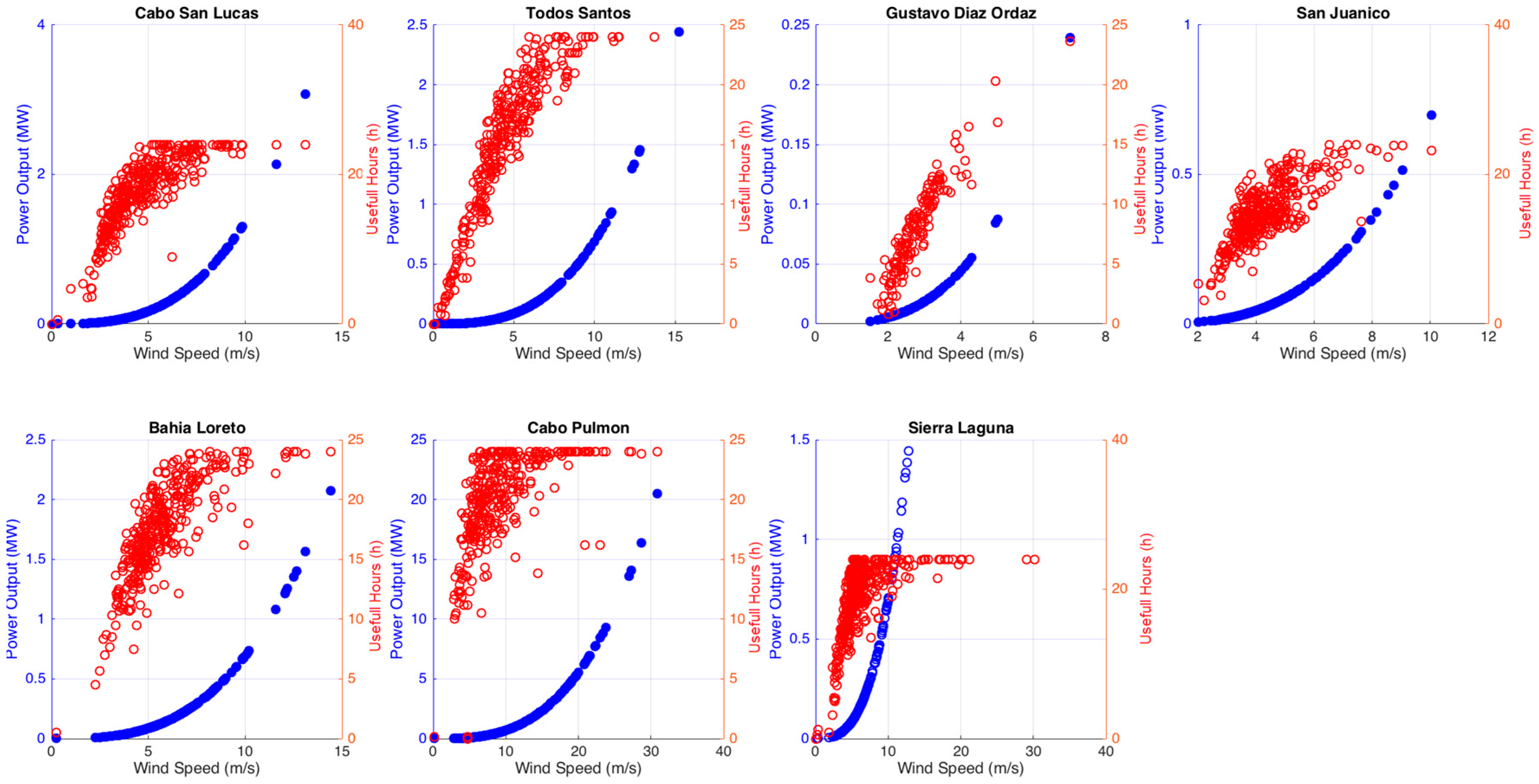
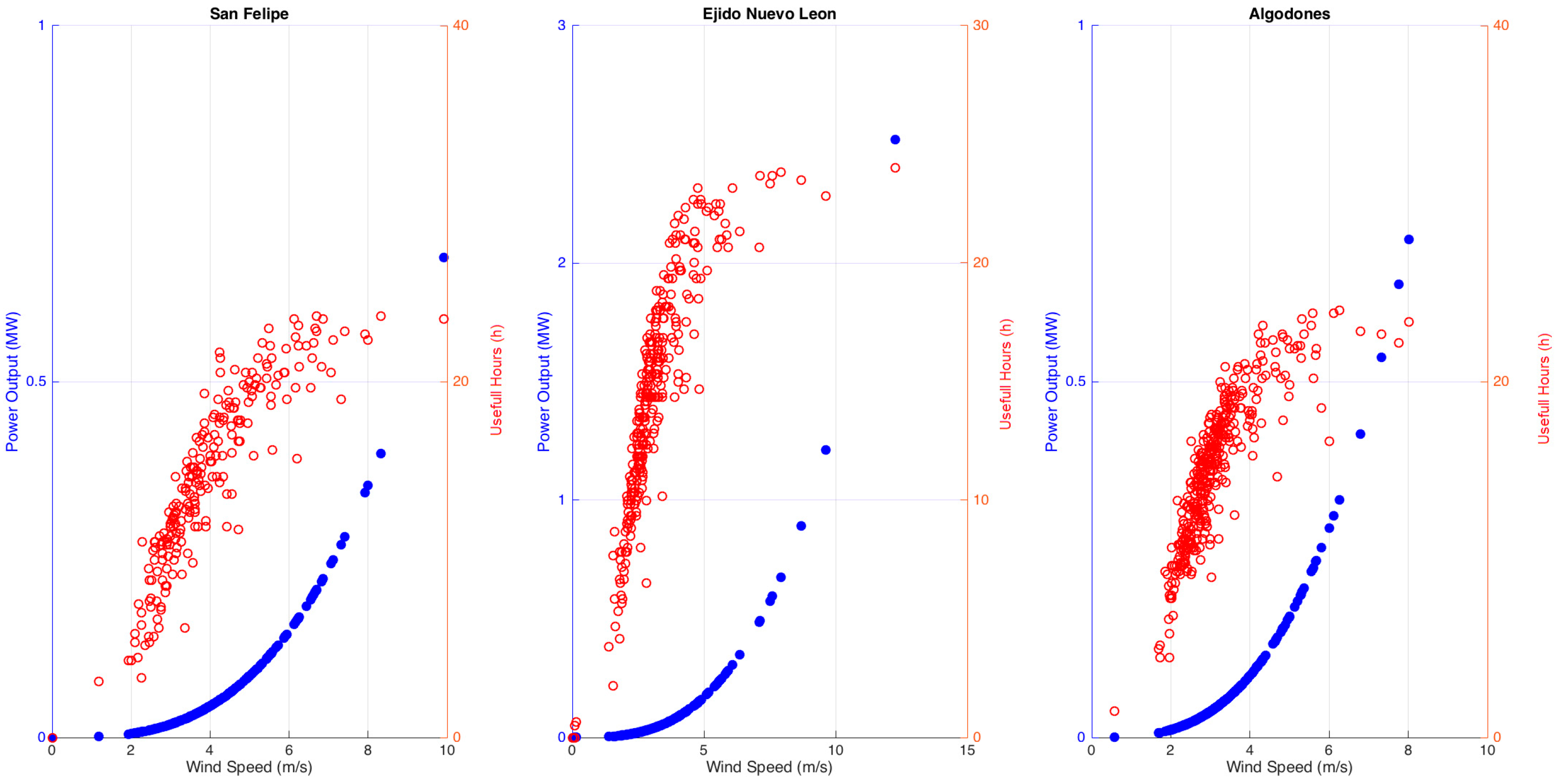
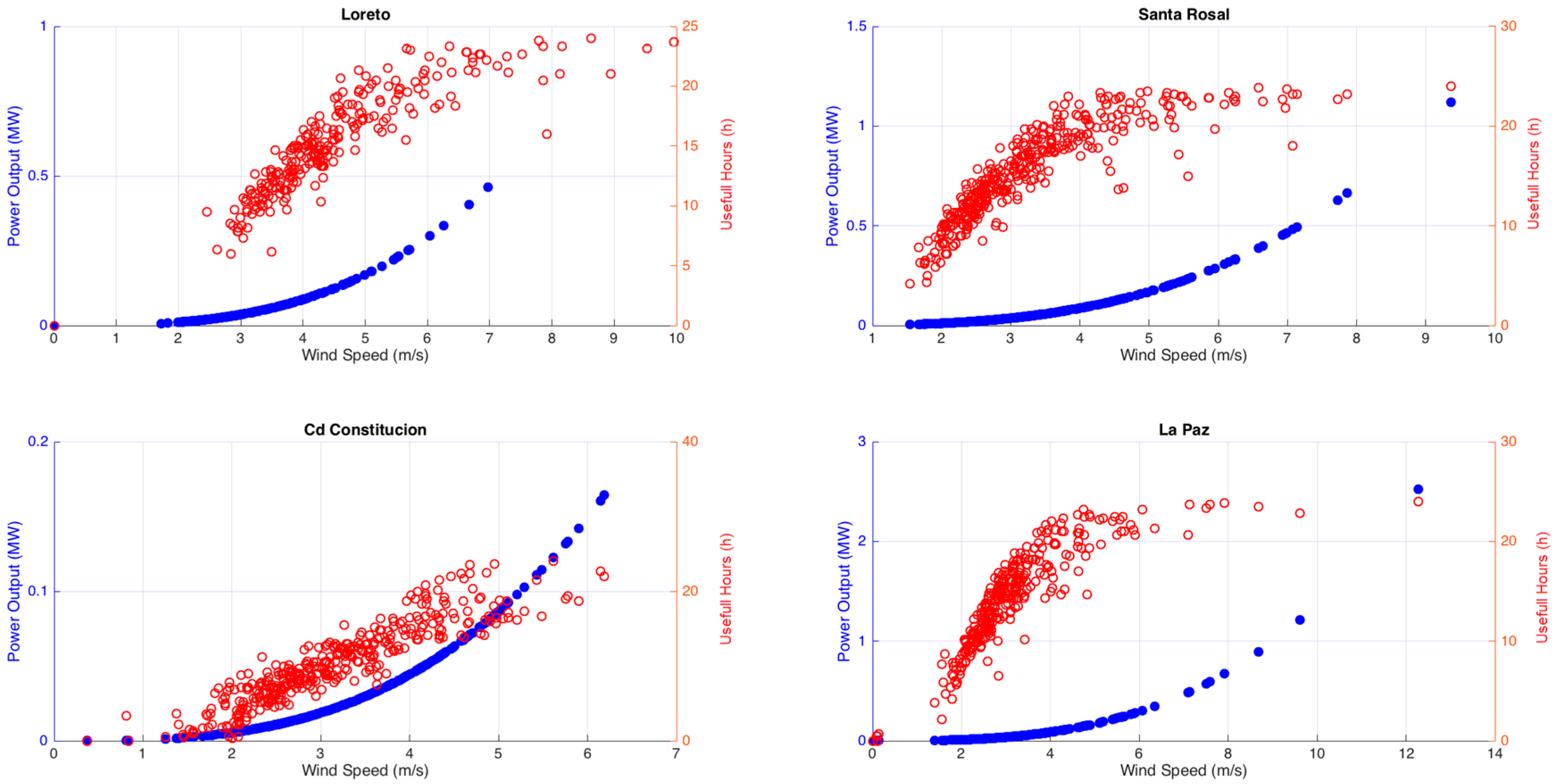
| State | Source | ||
|---|---|---|---|
| AMSs | SAMSs | SMSE | |
| Baja California | 10 | 3 | 25 |
| Baja California Sur | 7 | 4 | 55 |
| State | Source | Meteorological Station | R-Square (%) | SD (σ) | Bias (m/s) | RMSE (m/s) | Source |
|---|---|---|---|---|---|---|---|
| Baja California | AMSs | Presa_Abel | 0.84 | 0.296 | −0.039 | 0.1559 | SMSE_1 |
| Baja California | AMSs | Presa_Emilio | 0.94 | 0.341 | 0.366 | 0.09359 | SMSE_2 |
| Baja California | AMSs | Mexicali | 0.79 | 0.331 | 0.226 | 0.1793 | SMSE_3 |
| Baja California | AMSs | San Quintin | 0.96 | 0.451 | 0.258 | 0.07969 | SMSE_4 |
| Baja California | AMSs | Bahia Ange | 0.77 | 0.415 | −0.041 | 0.1851 | SMSE_5 |
| Baja California | AMSs | Catavina | 0.77 | 0.528 | 0.268 | 0.1889 | SMSE_8 |
| Baja California | AMSs | La_Rumorosa | 0.61 | 0.533 | −0.065 | 0.3052 | SMSE_9 |
| Baja California | AMSs | Cons_1857 | 0.70 | 0.423 | −0.167 | 0.2684 | SMSE_10 |
| Baja California | AMSs | Playas_Rosa | 0.71 | 0.452 | 0.129 | 0.265 | SMSE_11 |
| Baja California | AMSs | Tecate | 0.62 | 0.390 | 0.468 | 0.3203 | SMSE_14 |
| Baja California Sur | AMSs | Todos_Santos | 0.72 | 0.555 | 0.057 | 0.283 | SMSE_12 |
| Baja California Sur | AMSs | Cabo_SanLucas | 0.74 | 0.325 | 0.307 | 0.2564 | SMSE_15 |
| Baja California Sur | AMSs | Gust_Diaz_O | 0.71 | 0.412 | 0.617 | 0.2709 | SMSE_16 |
| Baja California Sur | AMSs | San_Juanico | 0.88 | 0.549 | 0.006 | 0.1433 | SMSE_17 |
| Baja California Sur | AMSs | Bahia_Loreto | 0.81 | 0.475 | 0.089 | 0.1794 | SMSE_18 |
| Baja California Sur | AMSs | Cabo_Pulmon | 0.86 | 0.806 | 0.054 | 0.199 | SMSE_19 |
| Baja California Sur | AMSs | Sierra_Laguna | 0.83 | 0.733 | 0.173 | 0.2028 | SMSE_20 |
| Baja California | SAMSs | San Felipe | 0.72 | 0.706 | 0.116 | 0.2918 | SMSE_21 |
| Baja California | SAMSs | Ejido_Nleon | 0.63 | 0.657 | 0.656 | 0.3298 | SMSE_22 |
| Baja California | SAMSs | Algodones | 0.84 | 0.504 | 0.231 | 0.1742 | SMSE_25 |
| Baja California Sur | SAMSs | Loreto | 0.79 | 0.322 | −0.002 | 0.2872 | SMSE_23 |
| Baja California Sur | SAMSs | Santa_Rosa | 0.73 | 0.307 | 0.099 | 0.184 | SMSE_24 |
| Baja California Sur | SAMSs | Cd_Consti | 0.85 | 0.522 | −0.077 | 0.1698 | SMSE_30 |
| Baja California Sur | SAMSs | La Paz | 0.72 | 0.474 | −0.615 | 0.2158 | SMSE_31 |
| State | Source | Met Station | Weibull Parameters | ||
|---|---|---|---|---|---|
| Mean | k | c | |||
| (m/s) | Dimensionless | (m/s) | |||
| Baja California | AMSs | Presa_Abel | 2.61 | 1.96 | 2.94 |
| Baja California | AMSs | Presa_Emilio | 3.18 | 1.98 | 3.58 |
| Baja California | AMSs | Mexicali | 3.40 | 1.92 | 3.83 |
| Baja California | AMSs | San Quintin | 3.29 | 1.88 | 3.71 |
| Baja California | AMSs | Bahia Ange | 5.25 | 1.23 | 5.86 |
| Baja California | AMSs | Catavina | 3.32 | 1.70 | 3.73 |
| Baja California | AMSs | La_Rumorosa | 3.90 | 2.05 | 4.41 |
| Baja California | AMSs | Cons_1857 | 3.22 | 1.53 | 3.57 |
| Baja California | AMSs | Playas_Rosa | 3.27 | 1.84 | 3.68 |
| Baja California | AMSs | Tecate | 3.21 | 1.99 | 3.62 |
| Baja California Sur | AMSs | Todos_Santos | 2.70 | 1.68 | 3.03 |
| Baja California Sur | AMSs | Cabo_SanLucas | 5.36 | 2.08 | 6.06 |
| Baja California Sur | AMSs | Gust_Diaz_O | 2.45 | 2.17 | 2.76 |
| Baja California Sur | AMSs | San_Juanico | 3.55 | 1.88 | 4.00 |
| Baja California Sur | AMSs | Bahia_Loreto | 4.63 | 1.72 | 4.63 |
| Baja California Sur | AMSs | Cabo_Pulmon | 7.89 | 1.55 | 8.77 |
| Baja California Sur | AMSs | Sierra_Laguna | 5.32 | 1.55 | 5.92 |
| Baja California | SAMSs | San Felipe | 8.04 | 2.62 | 9.05 |
| Baja California | SAMSs | Ejido_Nleon | 3.78 | 1.93 | 4.26 |
| Baja California | SAMSs | Algodones | 4.42 | 1.72 | 4.96 |
| Baja California Sur | SAMSs | Loreto | 3.88 | 1.93 | 4.37 |
| Baja California Sur | SAMSs | Santa_Rosa | 5.22 | 1.62 | 5.22 |
| Baja California Sur | SAMSs | Cd_Consti | 4.65 | 1.97 | 5.24 |
| Baja California Sur | SAMSs | La Paz | 5.42 | 1.67 | 6.10 |
| State | Source | Met Station | Mean Net Power Output | Mean Net Energy Output | Useful Hours |
|---|---|---|---|---|---|
| (kW) | (KWh/Year) | (h/Year) | |||
| Baja California | AMSs | Presa_Abel | 70.1 | 613,748 | 4359 |
| Baja California | AMSs | Presa_Emilio | 66.0 | 578,123 | 4374 |
| Baja California | AMSs | Mexicali | 84.8 | 743,249 | 4726 |
| Baja California | AMSs | San Quintin | 80.3 | 703,236 | 5013 |
| Baja California | AMSs | Bahia Ange | 292.2 | 2559,976 | 6148 |
| Baja California | AMSs | Catavina | 63.7 | 558,026 | 4330 |
| Baja California | AMSs | La_Rumorosa | 92.2 | 807,843 | 6147 |
| Baja California | AMSs | Cons_1857 | 66.6 | 583,506 | 4206 |
| Baja California | AMSs | Playas_Rosa | 99.2 | 868,801 | 5339 |
| Baja California | AMSs | Tecate | 90.1 | 789,438 | 5242 |
| Baja California Sur | AMSs | Todos_Santos | 105.6 | 925,343 | 5371 |
| Baja California Sur | AMSs | Cabo_SanLucas | 338.8 | 2967,533 | 6271 |
| Baja California Sur | AMSs | Gust_Diaz_O | 35.8 | 313,805 | 3450 |
| Baja California Sur | AMSs | San_Juanico | 132.4 | 1,160,157 | 5459 |
| Baja California Sur | AMSs | Bahia_Loreto | 224.3 | 1,964,598 | 6287 |
| Baja California Sur | AMSs | Cabo_Pulmon | 408.4 | 3,577,428 | 7050 |
| Baja California Sur | AMSs | Sierra_Laguna | 248.2 | 2,174,226 | 4417 |
| Baja California | SAMSs | San Felipe | 541.5 | 4,743,499 | 5225 |
| Baja California | SAMSs | Ejido_Nleon | 147.0 | 1,287,896 | 5290 |
| Baja California | SAMSs | Algodones | 209.5 | 1,835,341 | 5502 |
| Baja California Sur | SAMSs | Loreto | 162.4 | 1,422,930 | 5382 |
| Baja California Sur | SAMSs | Santa_Rosa | 260.8 | 2,284,364 | 5674 |
| Baja California Sur | SAMSs | Cd_Consti | 249.1 | 2,182,049 | 4438 |
| Baja California Sur | SAMSs | La Paz | 337.7 | 2,958,551 | 5584 |
© 2016 by the author; licensee MDPI, Basel, Switzerland. This article is an open access article distributed under the terms and conditions of the Creative Commons Attribution (CC-BY) license (http://creativecommons.org/licenses/by/4.0/).
Share and Cite
Hernandez-Escobedo, Q. Wind Energy Assessment for Small Urban Communities in the Baja California Peninsula, Mexico. Energies 2016, 9, 805. https://doi.org/10.3390/en9100805
Hernandez-Escobedo Q. Wind Energy Assessment for Small Urban Communities in the Baja California Peninsula, Mexico. Energies. 2016; 9(10):805. https://doi.org/10.3390/en9100805
Chicago/Turabian StyleHernandez-Escobedo, Quetzalcoatl. 2016. "Wind Energy Assessment for Small Urban Communities in the Baja California Peninsula, Mexico" Energies 9, no. 10: 805. https://doi.org/10.3390/en9100805
APA StyleHernandez-Escobedo, Q. (2016). Wind Energy Assessment for Small Urban Communities in the Baja California Peninsula, Mexico. Energies, 9(10), 805. https://doi.org/10.3390/en9100805





